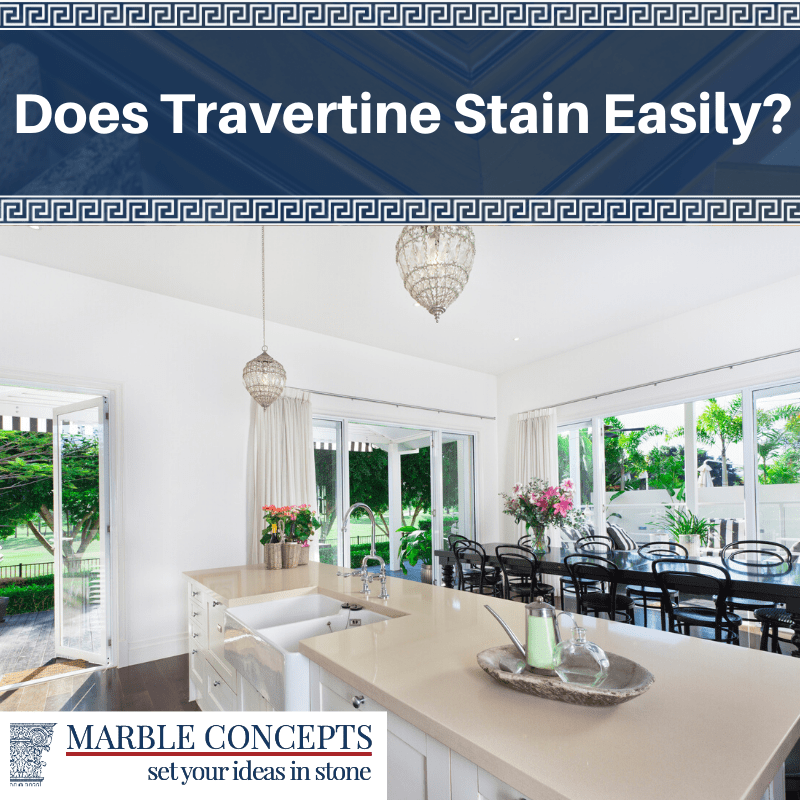Travertine is easy to clean and maintain as long you understand its properties. When you care for it properly, it’s a durable material that can retain its good looks for decades.
Travertine is a stone similar to marble and limestone. It is versatile enough to work with almost any decor. While it can stand up to a lot of punishment, it can be delicate under certain circumstances. For one thing, it is not as dense as granite. You will have to take steps to protect it.
Travertine is Susceptible to Etching and Staining
Acidic substances like wine or juice can easily etch travertine’s finish, which is why it is not recommended for making kitchen or bathroom countertops; however, it should be fine for a backsplash or floor. Travertine is vulnerable to stains but you can usually prevent them by sealing it. Keep in mind that etching and staining are two different things that will require different protective measures.
You Will Need to Seal Travertine to Protect
Sealing travertine is a relatively simple process that is usually as easy as wiping on the sealer and then wiping it off. Honed and tumbled travertine are the two types most likely to pick up stains and thus require sealing. Polished travertine is highly stain-resistant so you probably won’t need to seal it.
The first thing to do is to perform the water drop test to see whether a seal is necessary at all. Drip some water onto the countertop and start a stopwatch. If the water drops darken in 4 to 5 minutes, you will need to seal the countertop with multiple coats of sealer. Until you seal it, you will need to wipe up any spills quickly.
Stains vs. Etch marks
A sealer only protects travertine against stains, not etch marks. The difference between the two may be confusing to some consumers. Stains are marks that occur when a substance is absorbed into the stone. A sealer will keep anything from soaking into the stone. Etching is corrosion that comes from contact with acidic substances and is similar to a burn. Because etching is actual physical damage to the travertine, a sealer will provide no protection.
How to Clean and Protect Travertine
- Clean up spills right away. This is especially important for acidic liquids including sodas and fruit juices.
- Use a soft sponge to clean the surfaces. For regular cleaning, avoid standard cleaning products and use only hot water and a stone cleaner no more than once a day. Dry the travertine off with a soft cotton cloth. You can use a mild soap on your travertine a few times per year.
- Prevent the need to clean travertine in the first place by using coasters under glasses, bottles and cans.
- For a bathroom countertop, keep toiletries on a tray or other container. Many toiletries contain chemicals that can damage the surface of travertine.
- Clean your travertine floor tiles regularly with a dust mop and mop them with a floor cleaner formulated for stone floors.
- Use doormats on the inside and the outside to keep dirt and sand from being tracked inside on shoes. The grit on shoes is often abrasive and can cause wear on travertine floors.
- Never clean travertine floors with generic cleaning products. These cleaners contain chemicals that can etch the surface or break the sealer down and make it easy to stain. This includes bathroom tile cleaners. They contain abrasives that can scratch the surface of travertine.
- Don’t sit or stand on travertine countertops. They don’t flex like laminate, which means that too much weight in one place can cause cracking.
- Make a poultice. If your travertine does get stained and stone cleaners don’t help, you can use a poultice made with stone cleaner and baking powder to cover the stains. Cover the poultice with plastic wrap and let it sit for a few days to draw the stain out. You can then wash it off with warm water and buff the surface with a soft cotton cloth.
Travertine is an excellent stone that you can use throughout your home. It can greatly improve its value when it is properly maintained. If you need help cleaning or protecting your travertine surfaces, use our contact form to get in touch with us today.






